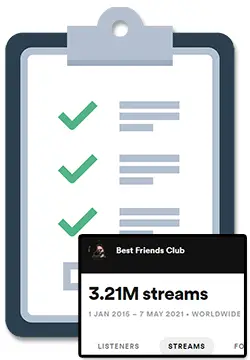As an independent musician, you have complete control over everything but also are held responsible for the results that you get.
This can feel like an overwhelming task for newer and more established indie artists alike, but it is 100% achievable with careful planning and execution.
In this blog post, we will explore the steps involved in releasing music independently based on what I’ve personally learned about releasing music as an independent artist over the last 10 years.
15-Step Checklist To Release Music Independently In 2023
Here are the 15 best steps you should follow if you want to properly release your music as an indie artist in 2023.
Instead of adding in lots of fluff like “making a press kit” or “registering for copyrights” that will overwhelm you and waste your precious time, this list focuses on only the steps that will move the needle for you.
- Define what “success” looks like for you as an indie artist
- Create a 6 – 12 month release plan
- Prepare your social media & artist profiles
- Prepare your music for release
- Get set up for music distribution
- Schedule your music for release
- Submit your music to Spotify’s editors
- Register your music to collect royalties
- Schedule social media posts to promote your music
- Set up digital ads to find new fans
- Email your fan mailing list
- Add your new release to your own Spotify playlist
- Engage with fans and listeners in the first 28 days
- Use analytics to adjust your release plan
- Analyze what worked & didn’t work for your release
- Get ready for your next release
P.S. For even more streamlined steps, follow the free checklist that I personally used to get my music streamed over 50,000 times on Release Radar and 5.9 million times on Spotify in general, click here to grab my free 7-step checklist. 🤗
1. Define what “success” looks like for you as an indie artist
Success as an indie artist varies from person to person – so it’s important to be clear on your goals before creating a plan.
It could mean achieving a certain number of streams or downloads, selling out a venue, receiving critical acclaim, or simply having the creative freedom to make the music you love.
I’ve found that a very common goal for artists in 2023 is to grow their Spotify, so we’ll focus on that particular goal for the rest of this checklist.
2. Create a 6 – 12 month release plan
It’s important to set specific goals and establish a long-term timeline so that you have a plan that you can follow along your journey of releasing music as an independent artist.
Make sure to include at least 1 or 2 months for you to prepare all the music needed and get set up with the proper accounts and tools.
For example, I’ve found that Facebook & Instagram ads can massively help promote a release, but can take a bit of legwork to get set up correctly – trying to cram this in with 3 days before your song comes out is a massive mistake.
You’ll then want to take stock of 6 – 12 songs that you want to release and map them out on a calendar.
3. Prepare your social media & artist profiles
Preparing your social media and artist profiles is important but is not crucial for building an online presence and promoting your music.
This includes creating or updating profiles on all relevant platforms, utilizing high-quality visuals, crafting a cohesive brand message, and engaging with your audience regularly.
Consistency and authenticity are the biggest keys to building a strong social media presence, so don’t overthink it, take a “done is better than perfect” approach, and move on to more pressing matters.
4. Prepare your music for release
Having all of the music you want to release for the next few months prepared and ready to go is an incredibly important step to releasing music in a way that gets great results without stressing you out.
Releasing and promoting your music can be challenging enough as it is. If you are rushing to finish music in time in addition to that you are simply setting yourself up to fail.
Preparing your music for release involves recording, mixing, and mastering your tracks as well as creating artwork and album information.
5. Get set up for music distribution
Getting set up for music distribution involves selecting a music distributor, creating an account, and uploading your music files and associated metadata.
It’s important to understand the features of each music distributor, including fees, how fast they are to upload music, and how reliable they are.
For help in picking the right distribution partner, check out my guide on the best music distribution services. 🙂
6. Schedule your music for release
It’s important to schedule your music for release at least 4 to 5 weeks ahead of the release date that you have planned.
This will allow you enough time to prepare for the rest of your music promotion like getting your pitch to the Spotify editors in time and scheduling social media posts and digital ad campaigns.
7. Submit your music to Spotify’s editors
Submitting your music to Spotify’s editors can increase your chances of being featured on playlists, which can lead to increased exposure and streaming numbers.
To do this, navigate to the Spotify for Artists dashboard, choose a track or album to submit, and provide relevant information about the release.
It’s important to note that not all submissions will be accepted for editorial playlists but will get in the Release Radar of all your Spotify followers which can give massive boosts to your streaming numbers.
8. Register your music to collect royalties
Registering your music with Performing Rights Organizations (PROs) is important for collecting all of the royalties that your music generates.
PROs such as ASCAP, BMI, and SESAC ensure that artists receive payment for the use of their music on various platforms, including radio, television, streaming services, and live performances.
To simplify your music royalty collection, I’d recommend taking a look at Songtrust.
9. Schedule social media posts to promote your music
Scheduling social media posts is a great way to promote your music and engage with your audience consistently without having to deal with the stress of creating and posting something each day.
It’s important to create a mix of promotional and non-promotional content and to experiment with different types of media, such as video and graphics.
10. Set up digital ads to find new fans
Setting up digital ads is a great way to expand your reach and find new fans, and has been a massive reason for how I’ve been able to get over 5.9 million streams on Spotify (so far).
Platforms such as Facebook, Instagram, and YouTube offer robust ad targeting options to reach specific audiences based on demographics, interests, and behaviors.
To learn more about getting started, check out my free Facebook Ads For Musicians guide. 🙂
11. Email your fan mailing list
Emailing your fan mailing list is a great way to keep your audience engaged and informed about your music and upcoming events.
If you have a mailing list, aim to get at least 1 email out before release day, 1 email out on release day, and 1 more email out a week or so after release day.
12. Add your new release to your own Spotify playlist
Adding your new release to your own Spotify playlist can help boost its visibility and increase streams – especially if you have been running campaigns to grow the number of followers on that playlist.
Take a moment on release day to add your new song to any Spotify playlists that you’ve been building up.
13. Engage with fans and listeners in the first 28 days
Engaging with fans and listeners in the first 28 days after your release is crucial for building momentum and maximizing your reach.
I can be a bit shy and sometimes find it hard to do this, but truly nurturing your fanbase and community should never be forgotten or automated.
This includes responding to comments and messages on social media and streaming platforms, sharing behind-the-scenes content, and creating exclusive content for your most engaged fans.
Encourage your fans to share your music and tag you in their posts to amplify your reach.
14. Analyze what worked & didn’t work for your release
Analyzing what worked and didn’t work for your release is important for optimizing future releases so that you can improve your results from release to release.
This includes tracking engagement metrics, such as streams, downloads, and social media engagement, as well as gathering feedback from fans and industry professionals.
Use this information to identify areas for improvement and experiment with new strategies for your next release.
15. Get ready for your next release
Releasing new music every 28 days can be a difficult task but is crucial for growing on Spotify:
Monthly releases help keep attention and momentum on your music. By releasing new content consistently, you’ll be able to guarantee that all eyes are on you as you push forward with your career.
Monthly releases can also help trigger the Spotify algorithm. The more music you release, the more data the algorithm has to work with, which can lead to increased visibility and streams.
So be sure to get ready to move on to your next release as soon as you can, my friend. 🙂



